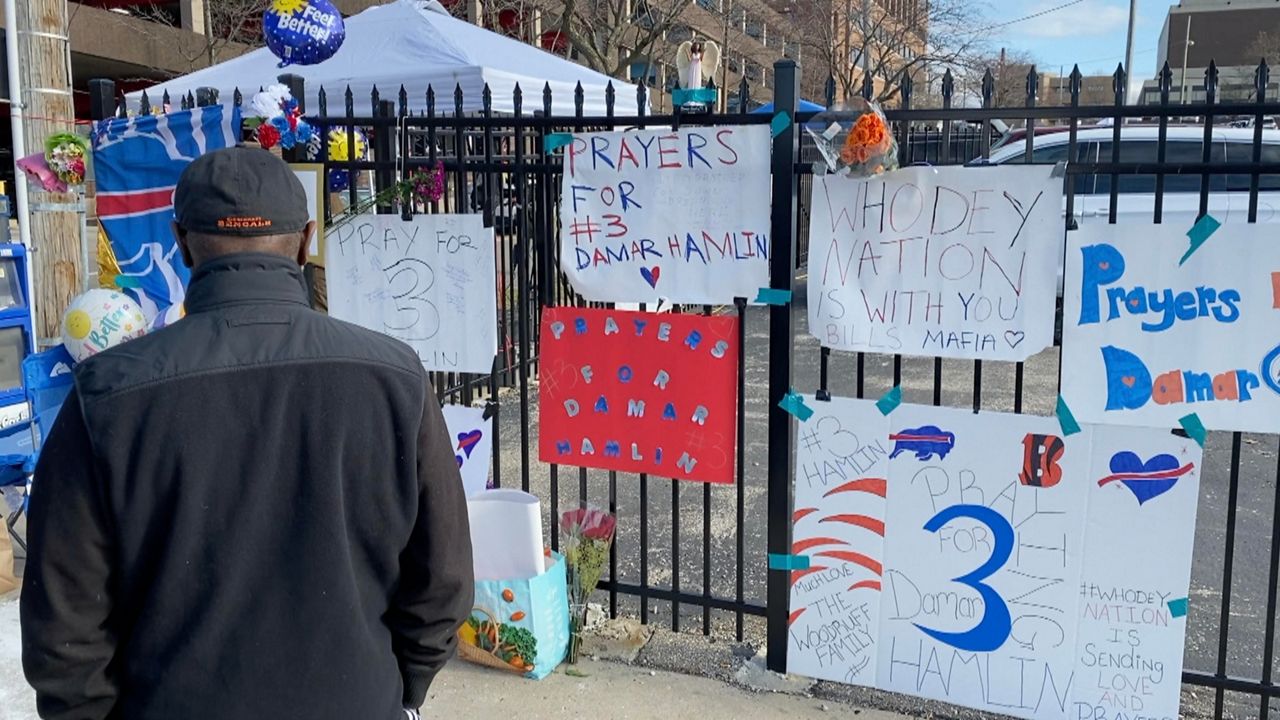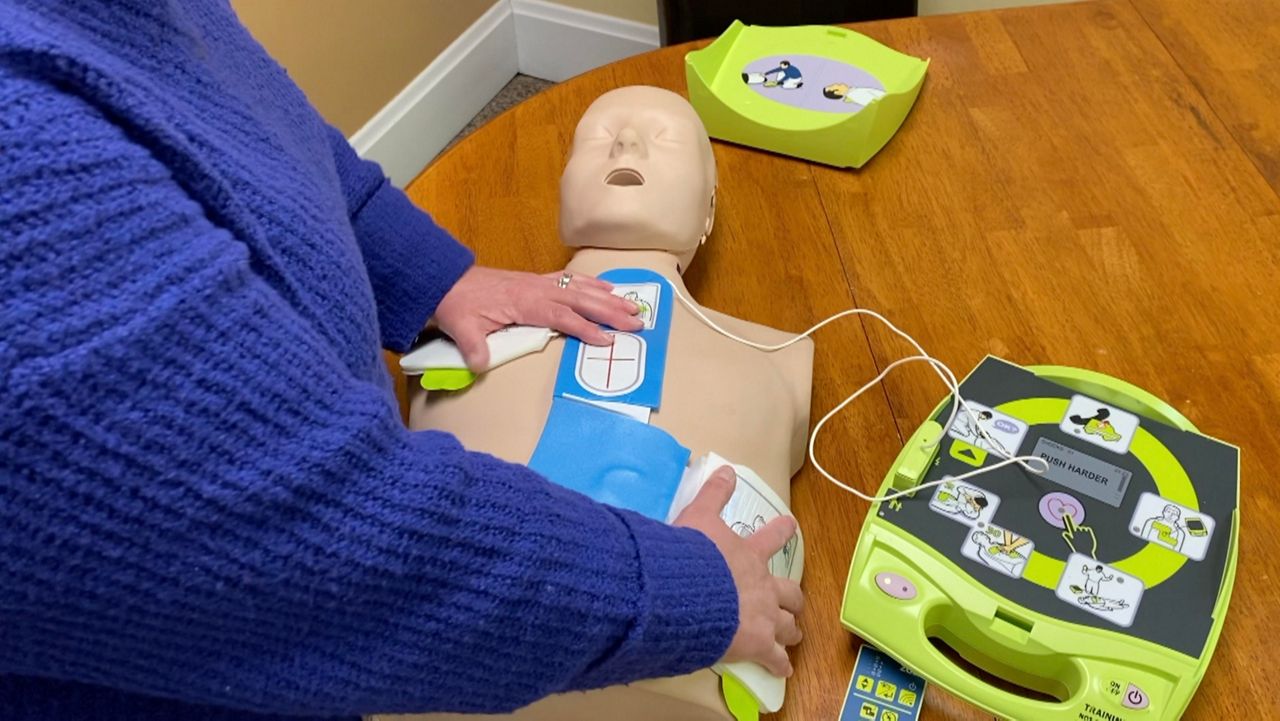FORT THOMAS, Ky. — A scary football injury that shocked the sports world very well could have claimed the life of Buffalo Bills player Damar Hamlin. However, almost immediately after Hamlin went into cardiac arrest on the field during a game against the Cincinnati Bengals, first responders provided their own shock, which may have saved Hamlin’s life.
Since that event, more people are signing up to learn how to potentially save the lives of their own loved ones in emergency situations.
Alysia Iacono, director of Northern Kentucky Emergency Medical Services, was at Paycor Stadium that day—not working, but watching the game with her family when Hamlin went down.
“I said, ‘This is bad. Like, this is really bad. I can’t believe this is going on,’” she said. “When you collapse and you’re in cardiac arrest, clinically you’re dead.”
Outside the stadium at a Cincinnati sports bar, Bengals fan Ronnie Gross was watching the game on television as Hamlin remained down on the field. Gross’ first instinct was to pray along with others around him.

Gross said he believes the outpouring of prayers for Hamlin from people around the country has allowed Hamlin to recover at the University of Cincinnati Medical Center. Outside of UC Health, people gathered, posting signs and showing support for Hamlin in the days following the incident. Gross said he came out to the site every day in anticipation of good news on Hamlin’s recovery.
“There’s something to be learned from this. And we can take it. And it’s up to you what you do with it,” Gross said.
Prayer may have given Hamlin the strength to fight for his life, but a shock to his system brought him back to life.
Seconds after he went down, medical personnel surrounded Hamlin on the field. Bills assistant athletic trainer Denny Kellington administered critical CPR. According to doctors, resuscitation and defibrillation restored Hamlin’s pulse. Iacono recalled the scene.
“It gives me goosebumps. I mean, it was just unreal. Nobody knew what to do. Nobody really knew what to say. It was very traumatic and disturbing for everybody,” she said.
Iacono said, in the time since, Northern Kentucky EMS has been busy.
“We’ve had quite a few calls from people wanting to purchase AEDs. We’ve had quite a few businesses reaching out, saying ‘we want to learn CPR,’” she said. “Unfortunately, it usually takes a tragedy for people to understand the importance of [CPR], and it really should be the opposite.”
Iacono has been training people to provide the kind care that saved Hamlin’s life for almost 20 years, just as her mother did before her when she started the business over 40 years ago.
When Northern Kentucky EMS first opened, it ran paramedic squads in northern Kentucky, but it no longer provides paramedic services. It’s been a training center for the American Heart Association for over 30 years.
The nonprofit organization also does a lot of training for state employees, and trains on AEDs, or automated external defibrillators.
“This is a take home skill. Because, whether you have to take it for your job, there is a higher percentage rate of someone performing CPR on a family member or a loved one, versus a work environment, or sometimes even out in public. So it’s really a great skill to have. Hopefully, you never have to use it, but it’s a good thing to know,” Iacono said.
She said if someone goes into cardiac arrest, call 9-1-1 immediately, and send someone to get an AED if one is available. The next step, Iacono said, is to start compressions, delivering 100 to 120 a minute, at least two inches deep into the center of the person’s chest with two hands. It’s recommended to compress to the rhythm of the song “Staying Alive.”
“Don’t ever be afraid to push too hard. You know, when someone’s in cardiac arrest, they are clinically dead. So you can’t hurt them anymore than they’re already hurting. So that’s the key is you want to push. You’re pushing hard, and you’re pushing fast,” Iacono said. “You always want the chest to come back up and recoil. Sometimes you’ll see people, they’ll just stay pushed down on the chest. They never let it come back up, and that’s not effective CPR.”
The goal is to have an AED hooked up within three minutes of a person in cardiac arrest collapsing.
“Don’t ever be afraid of them. If you hook somebody up, and you hit the shock button, and they don’t need to be shocked, these things have never misfired. So you can’t hurt somebody with an AED,” Iacono said. “So, you’ll turn it on, and it immediately starts talking.”

A voice from her AED test kit played, “Unit okay. Stay calm. Check responsiveness. Call for help. Attach defib pads to patient’s bare chest.”
After attaching the pads, the machine once again responded.
“Don’t touch patient. Analyzing… shock advised… press flashing shock button.”
Iacono pressed the button.
“Shock delivered. Start CPR.”
“If they don’t wake up, you’re gonna start your CPR,” Iacono said. “And if I’m not pushing hard enough, this AED will tell me.”
“Push harder,” the machine said.
“Once I have the correct depth of compressions…”
“Good compression.”
“And every time this machine beeps, you compress,” Iacono said.
The idea is to shock, do two minutes of CPR and repeat as needed or until an ambulance arrives.
“That’s really what’s going to save someone’s life, is if they can be shocked quickly. That’s why you’re seeing AEDs popping up in so many public places, because that’s really the key. CPR will help, but the big thing is to get that shock delivered to the heart in a very quick time,” Iacono said.
Gross said he was inspired after learning how the action taken in those initial, critical moments helped Hamlin. Doctors say he’s making significant improvement and even left Cincinnati and returned to Buffalo on Monday, Jan 9.
“We all should have a mindset. If it should happen around us, will we be prepared? Will we be ready? So, a CPR class should be on the forefront of everybody’s mind. It might be you that can save somebody in a certain situation, at a certain place,” Gross said.
He said he’ll continue to believe in the power of prayer, but also look into signing up for a CPR class.
In Kentucky, AEDs aren’t mandated in schools, though many schools have implemented them. Iacono said she thinks AEDs should be mandated at all schools and sporting events.
Anyone interested in signing up can visit NKEMS.org to schedule training for groups, or learn more about an open class that takes place once a month.



